|
Broadcast TV stations in the U.S.
have switched from analog to digital transmissions. This Fact
Sheet provides information on TV antennas and tips for obtaining
good quality reception of digital broadcasts.
What Kind of Antenna Do I Need to
Receive Digital TV Signals?
To receive digital TV signals from all
stations, it is important that your antenna be able to receive
both VHF channels (channels 2-13) and UHF channels (channels
14-51). Some antennas only provide good reception of VHF or UHF
channels, but not both. For example, indoor “rabbit ears”
usually need to be augmented with an additional “wire loop” or
“bowtie” antenna (see pictures below) in order to pick up
signals on UHF channels. Consumers should be aware that even if
they use a digital-to-analog converter box, they will still need
to use an antenna to receive DTV signals. Many of the antennas
currently being sold as “HDTV Antennas,” perform best at
receiving UHF signals; some of these models state that they
provide reception of signals on channels 7-13 but actually
perform less well receiving those channels. If you obtain one of
these antennas, be sure it provides good reception of all the
VHF channels as well as the UHF channels. The reception
capabilities of TV antennas also vary considerably, so be sure
to talk to retail consultants and look at information on the
packaging and/or the Internet to make sure that any new antenna
you may choose provides good reception of both VHF and UHF
channels. In addition, if you use an indoor antenna and receive
signals on VHF channels, you may need to use an antenna with
amplification. To check for the DTV signals that are available
at your location, use the DTV Reception Maps available at
www.fcc.gov/mb/engineering/maps.
Antennas for Reception in Different
Signal Conditions
The antennas shown below will work for the
indicated signal strength in most instances, but may not work in
all cases. Indoor reception of TV signals may be affected by
factors such as nearby buildings, trees, terrain, or home
construction.
|
Strong TV Signals |
|
|
|
|
|
VHF |
+ |
UHF |
Or |
Combined VHF/UHF |
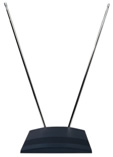 |
|
 |
|
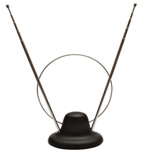 |
|
Simple
indoor antennas will usually be sufficient for
locations having strong TV signals. |
|
|
Moderate TV Signals |
|
|
|
High quality indoor antenna (check the box for information)
or an outdoor antenna may be appropriate. |
|
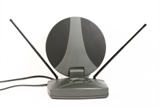 |
 |
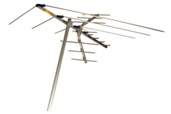 |
|
|
Weak TV Signals |
|
|
|
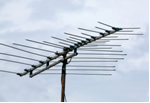 |
Outdoor antenna
is appropriate. |
 |
|
See
www.antennaweb.org for guidance on the type
of outdoor antenna you may need. |
|
You can check the signal
strength of your local stations at
www.fcc.gov/mb/engineering/maps/.
This Web page will help you find out whether you remained in the
coverage area of your local stations once they started
broadcasting in digital. In addition, for consumers who may wish
to purchase outdoor antennas, information on the appropriate
type of outdoor antenna for your location can be obtained at
www.antennaweb.org.
Note that the type of antenna needed at a specific location may
vary depending on geographic location, the height at which the
antenna is used, the presence of nearby structures and other
local factors.
Try Using Your Existing
Antenna First
If your television received
good quality reception on analog channels 2-51 with a broadcast
antenna, it should be able to receive digital television (DTV)
signals, including high definition television (HDTV) signals,
with the same antenna. You do not need to purchase a "DTV
antenna" or an “HDTV antenna” to receive DTV or HDTV signals;
however, your antenna must be able to receive both VHF and UHF
signals as indicated above.
Before making any changes to
your current antenna or antenna system, you should check, using
your digital-to-analog converter box or digital TV, to see if
your antenna receives the digital signals being broadcast in
your area. Once you have connected your digital-to-analog
converter box to your analog TV and to your antenna, you should
perform a “channel scan.” You should also perform a channel scan
if your antenna is connected to a digital TV. Digital-to-analog
converter boxes and digital TVs have a button, usually on the
remote control, that is labeled “set-up” or “menu” or some
similar term. Press that button to access the set-up menu. Using
the directional arrow buttons on your remote, scroll to the
option that allows you to search for digital broadcast channels
that are available in your area. Consult the owner’s manual of
your digital-to-analog converter box or digital TV for detailed
instructions on how to perform a channel scan for your device.
You should perform a channel scan periodically to check
whether additional digital channels have become available.
In many cases, this is all you need to do to watch digital
television broadcasts.
Flowchart for diagnosing
reception problems
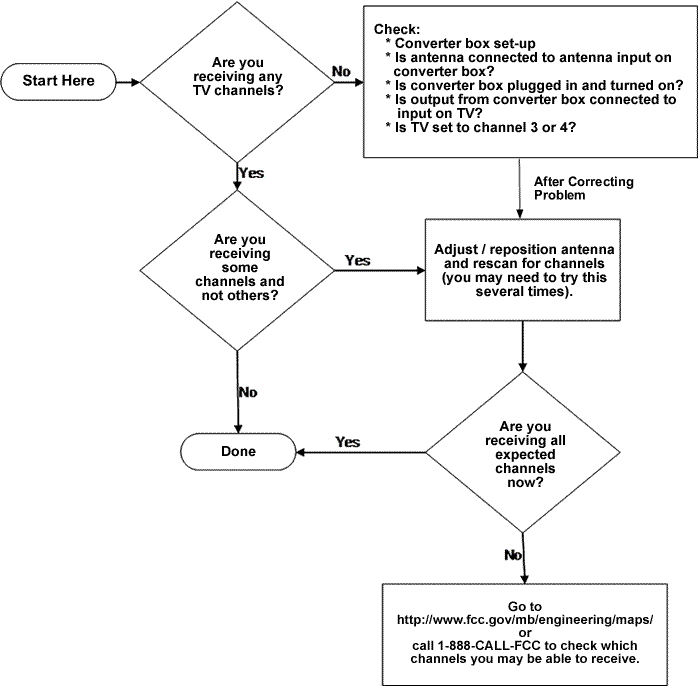
Reception Tips
-
Digital TV reception can
often be improved just by changing the location of your
current antenna, even as little as a few inches. For
example, moving it away from other objects or placing it
higher or lower can often improve reception. Be sure to move
the antenna slowly as digital TV tuners need a little time
to properly detect the signal. You need to rescan for
available signals if you are missing channels.
-
Antennas typically need to
be oriented or “aimed” to get the best signal from the
desired station. While adjusting your antenna, it may be
helpful to access the “signal strength meter” on your
digital-to-analog converter box or digital television to
determine whether your adjustments are improving the
signals’ strength. The signal strength meter is usually
accessed through the menu feature on your remote control.
Refer to the owner’s manual of your device for detailed
instructions on how to access its signal strength meter.
Remember to do another channel scan after you have adjusted
your antenna. For outdoor antennas, a rotor that re-orients
the antenna can improve performance, particularly when
trying to receive stations that transmit from different
locations.
-
If you are unable to get
satisfactory reception with your current indoor antenna, you
may wish to add a clip-on bow-tie element (see picture
above) or obtain a combination indoor antenna that includes
features for reception of both VHF and UHF signals and/or an
amplifier to boost the received signal.
-
Generally, an
outdoor antenna will get better reception than an indoor
antenna.
-
If you are near a
station’s broadcast tower, reception of that station, as
well as other stations, can be impeded by strong signal “overload.”
-
If you decide to
replace or upgrade your outdoor antenna, websites such as
www.antennaweb.org provide information on the
locations of broadcast transmitters and the types of outdoor
antennas appropriate for the stations you wish to receive.
If you need assistance with upgrading your antenna system,
check with a local antenna retailer or antenna installer.
-
If you are not receiving
certain digital TV stations, this does not necessarily mean
there is a problem with your antenna or receiver. Check with
the TV station to find out whether they are planning changes
that will improve reception.
-
To check for the DTV signals that are available
at your location, use the DTV Reception Maps available at
www.fcc.gov/mb/engineering/maps.
For More Information
About The DTV Transition
For more information about the DTV
transition, go to www.dtv.gov
or contact the FCC by e-mailing
fccinfo@fcc.gov; calling 1-888-CALL-FCC (1-888-225-5322)
voice or 1-888-TELL-FCC (1-888-835-5322) TTY; faxing
1-866-418-0232; or writing to:
Federal Communications Commission
Consumer & Governmental Affairs Bureau
Consumer Inquiries and Complaints Division
445 12th Street, SW
Washington, DC 20554
|